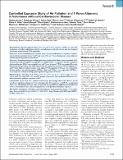| dc.contributor.author | Kusha, Marjan | |
| dc.contributor.author | Masse, Stephane | |
| dc.contributor.author | Farid, Talha | |
| dc.contributor.author | Urch, Bruce | |
| dc.contributor.author | Silverman, Frances | |
| dc.contributor.author | Brook, Robert D | |
| dc.contributor.author | Mangat, Iqwal | |
| dc.contributor.author | Speck, Mary | |
| dc.contributor.author | Nair, Krishnakumar | |
| dc.contributor.author | Poku, Kwaku | |
| dc.contributor.author | Wellenius, Gregory A | |
| dc.contributor.author | Nanthakumar, Kumaraswamy | |
| dc.contributor.author | Gold, Diane R. | |
| dc.contributor.author | Chris, Meyer | |
| dc.contributor.author | Mittleman, Murray A. | |
| dc.date.accessioned | 2013-04-22T13:55:35Z | |
| dc.date.issued | 2012 | |
| dc.identifier.citation | Kusha, Marjan, Stephane Masse, Talha Farid, Bruce Urch, Frances Silverman, Robert D Brook, Diane R Gold et al. 2012. Controlled exposure study of air pollution and T-wave alternans in volunteers without cardiovascular disease. Environmental Health Perspectives 120(8): 1157-1161. | en_US |
| dc.identifier.issn | 0091-6765 | en_US |
| dc.identifier.issn | 1552-9924 | en_US |
| dc.identifier.uri | http://nrs.harvard.edu/urn-3:HUL.InstRepos:10579105 | |
| dc.description.abstract | Background: Epidemiological studies have assessed T-wave alternans (TWA) as a possible mechanism of cardiac arrhythmias related to air pollution in high-risk subjects and have reported associations with increased TWA magnitude. Objective: In this controlled human exposure study, we assessed the impact of exposure to concentrated ambient particulate matter (CAP) and ozone (O:3) on T-wave alternans in resting volunteers without preexisting cardiovascular disease. Methods: Seventeen participants without preexisting cardiovascular disease were randomized to filtered air (FA), CAP (150 μg/m3), O3 (120 ppb), or combined CAP + O3 exposures for 2 hr. Continuous electrocardiograms (ECGs) were recorded at rest and T-wave alternans (TWA) was computed by modified moving average analysis with QRS alignment for the artifact-free intervals of 20 beats along the V2 and V5 leads. Exposure-induced changes in the highest TWA magnitude (TWAMax) were estimated for the first and last 5 min of each exposure (TWAMax_Early and TWAMax_Late respectively). ΔTWAMax (Late–Early) were compared among exposure groups using analysis of variance. Results: Mean ± SD values for ΔTWA:Max were –2.1 ± 0.4, –2.7 ± 1.1, –1.9 ± 1.5, and –1.2 ± 1.5 in FA, CAP, O3, and CAP + O3 exposure groups, respectively. No significant differences were observed between pollutant exposures and FA. Conclusion: In our study of 17 volunteers who had no preexisting cardiovascular disease, we did not observe significant changes in T-wave alternans after 2-hr exposures to CAP, O:3, or combined CAP + O3. This finding, however, does not preclude the possibility of pollution-related effects on TWA at elevated heart rates, such as during exercise, or the possibility of delayed responses. | en_US |
| dc.language.iso | en_US | en_US |
| dc.publisher | National Institute of Environmental Health Sciences | en_US |
| dc.relation.isversionof | doi:10.1289/ehp.1104171 | en_US |
| dc.relation.hasversion | http://www.ncbi.nlm.nih.gov/pmc/articles/PMC3440072/pdf/ | en_US |
| dash.license | LAA | |
| dc.title | Controlled Exposure Study of Air Pollution and T-Wave Alternans in Volunteers without Cardiovascular Disease | en_US |
| dc.type | Journal Article | en_US |
| dc.description.version | Version of Record | en_US |
| dc.relation.journal | Environmental Health Perspectives | en_US |
| dash.depositing.author | Gold, Diane R. | |
| dc.date.available | 2013-04-22T13:55:35Z | |
| dc.identifier.doi | 10.1289/ehp.1104171 | * |
| dash.authorsordered | false | |
| dash.contributor.affiliated | Gold, Diane | |
| dash.contributor.affiliated | Mittleman, Murray | |


